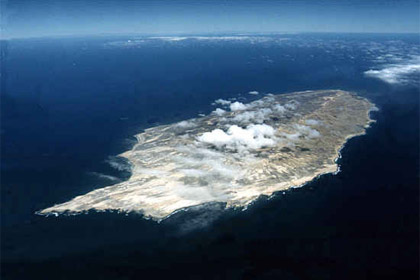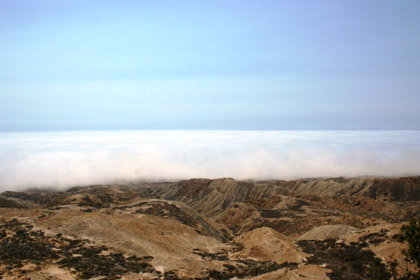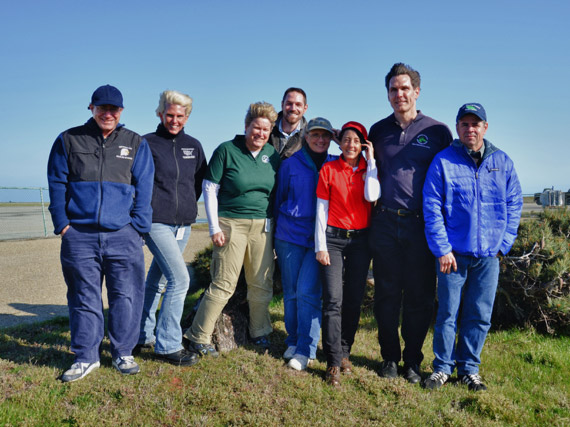Naval Base Ventura County San Nicolas Island Seabird Restoration Project
San Nicolas Island (SNI), the most remote of California’s Channel Islands, has been touched and transformed by humans beginning with its occupancy by the Nicoleño Indians approximately 12,000 years ago through ranching operations in the 19th Century to its current site as a U.S. Navy missile testing area. Beyond the boundaries of the island, in waters approximately 60 miles off the Ventura County coast, human impacts to the marine environment have had long-lasting effects on the island’s ecosystem. With a varied topography of canyons, dunes, flatlands and beach areas, the island supports an array of endemic species including the SNI fox, island night lizard and native deer mice. Other species, such as northern elephant seals, Brandt’s cormorants, western gulls and the federally protected western snowy plover, breed and rear their young here.
A concerted effort between a diverse group of partners enabled Naval Base Ventura County (NBVC) to successfully complete a Seabird Restoration Project on SNI involving the removal of feral cats. The partnership, which comprised representatives from the U.S. Navy, Montrose Settlement Trustee Council, Institute for Wildlife Studies, Island Conservation and Humane Society of the United States, worked together to restore the island ecosystem. This has resulted in improved nesting success for seabirds and has also provided benefits to threatened and endangered species. Although the project was a complex and difficult undertaking, the group worked in a collaborative manner to reach a solution that met the needs of the various parties. It is an accomplishment that can serve as a model for future island restoration efforts carried out worldwide in support of natural ecosystems.
San Nicolas Island & Feral Cats
San Nicolas Island has been under U.S. Navy ownership since the 1940s. Permanent changes have resulted from the military’s presence, which include an active runway and a small cluster of buildings on the island’s northern section, known as NicTown. The latter provides the infrastructure needed to support the 150 to 200 personnel stationed on the island at any given time. Previous uses of the island, including the introduction of sheep ranching, have left indelible scars on the land and have altered the island’s historic ecosystem. However, under the stewardship of the Navy, SNI is slowly recovering. The removal of sheep has enabled native vegetation to take root again and efforts to protect native species from unnecessary disturbance have helped restore a more natural biological rhythm.
But one introduced predator – the feral cat (felis catus) – continued to take a toll on native wildlife. Although the U.S. Navy has been actively working to balance mission-critical activities on San Nicolas Island with environmental stewardship, the wily feral cats proved time and again to be a difficult animal to remove. No one knows exactly when cats were introduced to the island.

Photo Credit: Naval Air Warfare Center Weapons Division | San Nicolas Island
But, the general agreement is that it was probably sometime in the 1950s when military personnel coming to the island brought along a cat or two to keep mice out of food stores and, perhaps, for companionship. When personnel rotated back to the mainland, the cats were left behind, reverting to a feral state.
Until the arrival of cats on the island, the only predator of ground-nesting birds, like the cormorants, gulls and plovers, was the island fox. Standing about one-foot high and weighing an average four pounds, the island fox feeds primarily on native deer mice, beetles, crickets and plant fruits. The more aggressive introduced feral cats directly competed with the fox for food, primarily deer mice, and they also preyed on the native seabirds, their eggs and young.
DDT & Marine Restoration Funding
In addition to predation, seabirds on San Nicolas and other Channel Islands have been affected by the chemical dumping of DDT into the ocean through an outfall pipe off the coast of Los Angeles County. These unchecked chemical discharges into the marine environment continued for about 40 years. “These chemicals are taken up by species at all levels of the food chain with the result being eggshell thinning in birds that consume contaminated fish,” says Seabird Biologist Annie Little, U.S. Fish and Wildlife Service. Contamination of the marine environment had profound effects on the Channel Islands ecosystems. Bald eagles disappeared from the islands by the 1960s, and native seabird populations declined. The concomitant effects of contaminants and the introduced feral cats were a double threat to SNI native seabird colonies.
In accordance with Sikes Act Improvement Act (SAIA), the Integrated Natural Resource Management Plan for San Nicolas Island identified removal of feral cats as an important project to benefit native wildlife. Beginning in the 1980s and continuing periodically through 2005, the Navy sought to remove the feral cats, but they proved elusive and enough remained to maintain the population. Subject to boom and bust cycles of the island’s rain and drought, the feral cat population was estimated to be somewhere between 150 and 200. Through a separate planning process, a possible solution to the island’s feral cat problem appeared in 2004.
After a multi-year effort, in 2000 final settlements were reached with the Montrose Chemical Company and others regarding the marine environment pollution caused by the DDT dumping. Administered by five federal and state agencies, the Montrose Settlements Restoration Program (MSRP) prepared a comprehensive restoration plan to aid natural resources affected by DDT contamination. Using $30 million in restoration funding, MSRP identified high-priority restoration projects, one of which was removal of feral cats from San Nicolas Island to improve seabird nesting success.
Impact of Public Sentiment
Representatives from the MSRP Trustee Council approached the Navy in 2004 to determine if removal of SNI feral cats was a project the Navy would support. It was clear from the outset that, even with Navy support, the task would be a complex undertaking. For instance, materials and personnel would have to be flown or shipped out to the island, and the process would have to yield to military activities.

Photo Credit: Annie Little, USFWS | Ramona Sanctuary
In addition, efforts to remove the feral cats would have to be done in a way that would cause the least amount of disruption or harm to the island’s native inhabitants, in particular the island fox. One additional hurdle to overcome was public sentiment: How would a plan that endorsed lethal removal of the cats be received?
In May 2007, the MSRP Trustee Council released a draft Environmental Assessment outlining the proposed plan. Its release generated more than 5,000 public comments, the majority of which opposed the lethal removal of the feral cats. But amidst the numerous angry emails and form letters was a comment letter from the Humane Society of the United States (HSUS). Although equally opposed to euthanizing feral cats, they offered to meet with all parties to attempt a workable solution. In Fall 2008, discussions occurred among the Navy, MSRP Trustee Council and HSUS. Employing a trap-neuter-release (TNR) strategy was not possible. The Navy has standing orders prohibiting use of TNR on its installations, and the MSRP Trustee Council did not support a project that would leave native seabirds and other island wildlife under continued threat of predation.
Another public concern involved the restoration project’s intended use of padded leg-hold traps, even though the cats would be captured alive. HSUS advocated the use of box traps, which led to biologists from the Institute for Wildlife Studies (IWS) and HSUS conducting experimental box trapping from November to the end of December 2008. During that time, 14 to100 box traps were set out each night (equaling about 1,200 trap nights) with only four cats caught. Conversely, during a one week period in January 2009, 16 padded leg-hold live traps (equivalent to 71 trap nights) resulted in the successful capture of three cats. It was clear the padded live leg-hold trap was the most efficient method for capturing feral cats.
For the project, each padded leg-hold trap was significantly modified to reduce the tension enough so that it would successfully hold a cat while being light enough to reduce injuring the island fox. This was an especially important consideration because a number of island foxes would likely be captured for each successfully trapped cat. Although provisions were made to cease all trapping during the island fox breeding season, it was still highly likely they would be accidentally trapped outside the breeding season. Each trap was equipped with a GPS telemetry alarm system pinpointing the location of the trap when sprung, thus enabling personnel to respond immediately to a trapped animal.
A Cooperative Result
The outstanding issue of what to do with the cats once trapped still remained. The MSRP Trustee Council did not support using its limited funding to provide care or housing for the feral cats. This potentially costly undertaking was perhaps the biggest hurdle to reaching a cooperative result. Fortunately, HSUS agreed to use their own funds specifically to cover health checks, vaccinations, spay/neuter surgery, microchipping, long-term care and transportation of the cats to the mainland where they would be housed in a permanent enclosed sanctuary run by HSUS and the Fund for Animals. Healthy kittens would be adopted out to suitable homes as indoor-only cats. This cooperative spirit, formalized in a Memorandum of Agreement signed December 2008, dramatically changed the project’s tenor.
The first full year of trapping was initiated June 2009.

Photo Credit: Jane Hendron, USFWS| A marine layer over the island.
Island Conservation, contracted to help design and implement the restoration project, coordinated with U.S. Navy personnel on a daily basis to determine which areas of the island were accessible in order to identify where traps could be placed. Radio communications also had to be coordinated in order not to interfere with military activity and radio communications. Weather was another concern because it complicated trapping efforts. For instance, the day could begin with sunshine, but, in a matter of hours, the island could be enveloped in a deep marine layer that drastically reduced visibility. Or, high winds would develop and buffet the island because it has virtually no trees or tall shrubbery.
IWS, a non-profit providing conservation research services, brought a state-of-the-art mobile wildlife hospital to the island to treat any island foxes inadvertently injured during the trapping effort. The organization also undertook the role of tending to the feral cats and preparing them for transport to the mainland. All equipment and personnel used to conduct the trapping effort was either flown in by plane or off-loaded by barge at the one pier available on the island. These logistical challenges added to the project’s cost and complexity.
Despite the challenges, the innovative trapping efforts yielded positive results. Within a few weeks, 19 feral cats were trapped, one of which was a pregnant female that gave birth to three kittens while in holding at the IWS mobile hospital. The cats were transported in groups by plane to the Ramona, Calif., airport and then driven to their new sanctuary nearby. Trapping efforts continued until January 2010 when the island fox breeding season began. The final two feral cats were detected and removed June 2010. A total of 66 adult cats and 10 kittens were removed from San Nicolas Island.
“No two projects are alike, and each has its own set of critical components that must come together to achieve success, much like a complex jigsaw puzzle. SNI, in particular, provided a unique opportunity for a diverse group of partners to each provide a piece to this puzzle. The end result is something we’re all proud to have been part of,” said Chad Hanson, project manager for Island Conservation.
To ensure all feral cats were removed from the island, the restoration project used 54 Reconyx remote cameras deployed throughout the island along known cat trails and potential territories. Between June 27, 2010, and December 9, 2011, the equivalent of 27,224 camera trap nights were completed before the project was declared a success.
A Pioneering Spirit
Although the project cost $3 million in MSRP funds, no price tag can be placed on long-term ecosystem restoration and the benefits that accrue to the entire suite of San Nicolas Island wildlife. The Navy cannot undo all past and ongoing impacts to SNI, but this restoration project demonstrates a pioneering spirit and way to remove feral cats on a large-scale without use of poisons or lethal methods, provided the right group of partners come together. The success of this project will enable it to serve as a model for future island restoration efforts carried out worldwide. San Nicolas Island is the 5th largest island in the world to have successfully removed all feral cats and the largest one that did not involve use of poison.
Naval Base Ventura County (NBVC) can now move forward with other projects to benefit the natural resources on SNI and to find a workable balance for the wildlife and military mission. Although the island will never be as it was prior to human settlement, opportunities still exist to help restore ecological balance and to promote long-term sustainability for its native wildlife. The removal of cats from SNI is an enormous compliment to NBVC’s ongoing Natural Resource Management Program for the island, which is helping to restore the ecosystem’s natural balance. NBVC looks forward to the future of San Nicolas Island and will continue to work with its partners and partnering agencies as it moves onward in its stewardship and observes the long term natural resource benefits from the Seabird Restoration Project.

Photo Credit: Jim Bartel, USFWS | Pictured from Left to Right are some of the partners involved with the Ramona Sactuary project: Dave Garcelon, Institute for Wildlife Studies; Jennifer Boyce, MSRP Program Manager; Kimberly D’Amico, The Humane Society of the United States; Chad Hanson, Island Conservation; Grace Smith, US Navy; Jane Hendron, US Fish and Wildlife Service; Dan Shide, US Navy; Martin Ruane, US Navy.




























